
Epacris impressa, also known as common heath, is a plant of the heath family, Ericaceae, that is native to southeast Australia. French botanist Jacques Labillardière collected the species in 1793 and described it in 1805. Four forms have been identified, but no subspecies are recognised. Growing in heathland, shrubland or open forest, it is generally a small shrub around 0.5 to 1 m tall, with small stiff leaves. The red, pink or white tube-like flowers appear from late autumn to early spring. Honeyeater birds, particularly the eastern spinebill, feed upon the nectar of the flowers. It regenerates after bushfire by seed or by resprouting.

The wagtails, longclaws and pipits are a family, Motacillidae, of small passerine birds with medium to long tails. There are around 65 species in 6 genera. The longclaws are entirely restricted to the Afrotropics, and the wagtails are predominantly found in Europe, Africa and Asia, with two species migrating and breeding in Alaska. The pipits have the most cosmopolitan distribution, being found across mostly in the Old World but occurring also in the Americas and oceanic islands such as New Zealand and the Falklands. Two African species, the yellow-breasted pipit and Sharpe's longclaw, are sometimes placed in a separate seventh genus, Hemimacronyx, which is closely related to the longclaws.

The yellow mongoose, sometimes referred to as the red meerkat, is a member of the mongoose family. It averages about 1 lb (1/2 kg) in weight and about 20 in (500 mm) in length. It lives in open country, from semi-desert scrubland to grasslands in Angola, Botswana, South Africa, Namibia, and Zimbabwe.
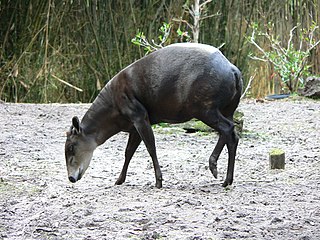
The yellow-backed duiker is a forest dwelling antelope in the order Artiodactyla from the family Bovidae. Yellow-backed duikers are the most widely distributed of all duikers. They are found mainly in Central and Western Africa, ranging from Senegal to Western Uganda with possibly a few in Gambia. Their range also extends southward into Rwanda, Burundi, Zaire, and most of Zambia.

Live food is living food for carnivorous or omnivorous animals kept in captivity; in other words, small animals such as insects or mice fed to larger carnivorous or omnivorous species kept either in a zoo or as a pet.

Acacia penninervis, commonly known as mountain hickory wattle, or blackwood, is a perennial shrub or tree is an Acacia belonging to subgenus Phyllodineae, that is native to eastern Australia.

The impressed tortoise, occurs in mountainous forest areas in Southeast Asia mainly in Myanmar Burma, southern China, Thailand, Laos, Vietnam, Cambodia, Malaysia and Northeast India. The species has a golden brown shell and skin. Adults are much smaller than their relatives the Asian forest tortoise, with a maximum size of 35 cm (14 in) carapace length.
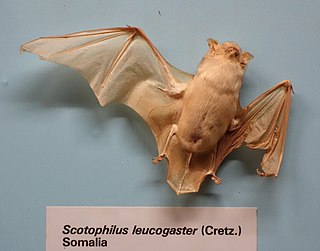
The white-bellied yellow bat or white-bellied house bat, is a species of vesper bat in the genus Scotophilus, the house bats. It can be found in Angola, Benin, Botswana, Burkina Faso, Cameroon, Central African Republic, Chad, Ivory Coast, Gambia, Ghana, Guinea, Guinea-Bissau, Kenya, Mali, Mauritania, Namibia, Niger, Nigeria, Senegal, Sierra Leone, Sudan, Togo, Uganda, and Zambia. It is found in dry and moist savanna and open woodland. It is a common species with a very wide range, and the International Union for Conservation of Nature has assessed its conservation status as being of "least concern".

Grevillea obtecta is a spreading shrub which is endemic to Victoria, Australia. It is known by the common names Fryerstown grevillea, Elphinstone grevillea, or Taradale grevillea. It grows to 0.5 metres in height and about 1.2 m in width The flowers, which are light green to yellow, appear between August and November in its native range.

Pachnoda sinuata, the garden fruit chafer or brown-and-yellow fruit chafer, is a species of beetle found in Namibia and South Africa.

Pachnoda is a genus from the subfamily Cetoniinae with nearly all of the species living in Africa. The limit of the genus is given by the presence of internal lobes in their aedeagi.

Rhabdotis albinigra is a species of Scarabaeidae, the dung beetle family. It was described by Hermann Burmeister in 1847.
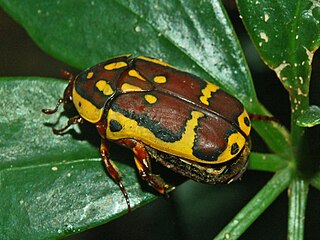
Pachnoda fissipunctum is an African scarab beetle in the subfamily Cetoniinae. It was originally described in 1885 as a variety of Pachnoda flavicollis.

Cheilosia impressa is a Palearctic species of hoverfly. Like most members of its genus C. impressa is a rather small, dark insect and identification can be problematic.

Pachnoda interrupta, commonly known as the sorghum chafer, is a species of beetle of the family Scarabaeidae and subfamily Cetoniinae.
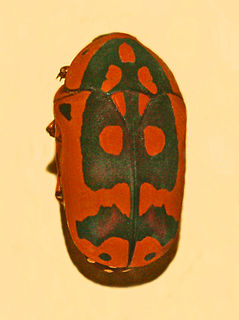
Pachnoda sinuata flaviventris, the garden fruit chafer, is a subspecies of beetle belonging to the family Scarabaeidae.
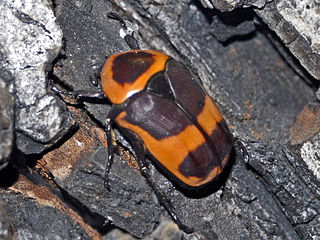
Pachnoda savignyi, the Sun Beetle, is a beetle belonging to the family Scarabaeidae.
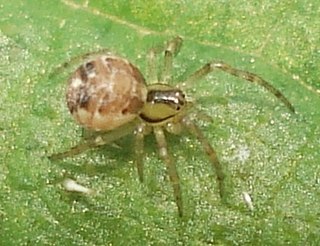
Phylloneta impressa is a species of comb-footed spider from the genus Phylloneta with a Holarctic distribution.
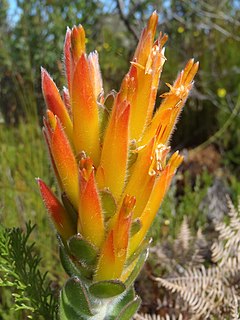
Mimetes pauciflorus, the three-flowered pagoda, is an evergreen, shyly branching, upright shrub of 2–4 (6½–13 ft) high, from the family Proteaceae. It has narrowly to broadly oval leaves of 2½–4 cm (1.0–1.6 in) long and ¾–2 cm (0.3–0.8 in) wide, on the upper parts of the branches, the lower parts leafless with a reddish brown bark. The inflorescences at the top of the shoots are cylinder-shaped, 10–40 cm (4–16 in) long and contain forty to one hundred twenty densely crowded flower heads, at a steep upward angle, hiding a crest of very small, almost vertical leaves. The flower heads each consist of three, rarely four individual flowers. The flowers are tightly enclosed by four or five orange-yellow, fleshy, pointy, lance-shaped involucral bracts, and three orange-yellow, 4–5½ cm (1.6–2.4 in) long bracteoles. It grows on always moist, south-facing slopes in the southern coastal mountains of South Africa. Flowers can be found from August to November, with a peak in September.

Mimetes saxatilis or limestone pagoda is an evergreen, upright, rarely branching shrub of 1–2¼ m high, assigned to the family Proteaceae. The approximately oval leaves are 3½–5 cm (1.4–2.0 in) long and 1½–3 cm (0.6–1.2 in) wide with a blunt, thickened, reddish tip or with three crowded teeth. It has cylinder-shaped inflorescences topped by a crest of green leaves, further consisting of heads with 12-22 individual bright yellow flowers, each in the axil of a flat, green leaf. It is an endemic species that is restricted to limestone outcrops in the Agulhas plains in the very south of the Western Cape province of South Africa. It is considered an endangered species. Flowering may occur between July and December, but is unreliable in its timing, dependent on sufficient moisture availability.




















